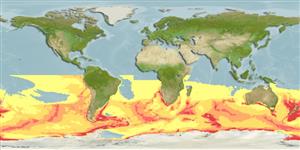Common names from other countries
Environment: milieu / climate zone / depth range / distribution range
Ecología
Batidemersal. Polar; 0°N - 90°S, 180°W - 180°E
Indo-Pacific, Atlantic Ocean, and the Antarctic.
Length at first maturity / Tamaño / Peso / Age
Maturity: Lm ? range ? - ? cm Max length : 300 cm TL macho / no sexado; (Ref. 1394); 360 cm TL (female); peso máximo publicado: 450.0 kg (Ref. 1394); peso máximo publicado: 450.0 kg
Found throughout the pack ice zone; haul out on ice and land, often preferring ice floes, when available. Feeds on krill, fish, squid, penguins, and young seals, and will occasionally scavenge from carcasses of whales (Ref. 1394). Found throughout the pack ice zone; haul out on ice and land, often preferring ice floes, when available. Feeds on krill, fish, squid, penguins, and young seals, and will occasionally scavenge from carcasses of whales (Ref. 1394).
Jefferson, T.A., S. Leatherwood and M.A. Webber. 1993. (Ref. 1394)
IUCN Red List Status (Ref. 130435)
CITES status (Ref. 108899)
Not Evaluated
Not Evaluated
Human uses
Pesquerías: comercial
FAO - pesquerías: species profile | FishSource | Sea Around Us
Herramientas
Fuentes de Internet
Estimates based on models
Preferred temperature
(Ref.
115969): -1.9 - 1.4, mean -0.5 (based on 2109 cells).
Resiliencia
Alto, población duplicada en un tiempo mínimo inferior a 15 meses (K=0.36-0.47).
Vulnerability
Very high vulnerability (90 of 100).
Price category
Unknown.
